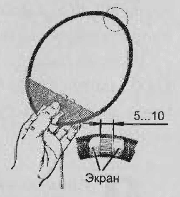
|
|
ENCYCLOPEDIA OF RADIO ELECTRONICS AND ELECTRICAL ENGINEERING High sensitivity metal detector. Encyclopedia of radio electronics and electrical engineering
Encyclopedia of radio electronics and electrical engineering / metal detectors Design features This metal detector is an improved version of a metal detector based on comparing the frequencies of two generators, one of which is a reference one, and the second is a search one - it changes the frequency of its oscillations when approaching metal objects. The device can "distinguish" non-ferrous and ferrous metals. Schematic diagram The reference generator is assembled on the element DD1.1, and the search generator is assembled on the elements DD2.1 and DD2.2. The oscillation frequency of the reference oscillator, determined by the data of its loop coil L1 and capacitors C1 and C2, and at the indicated ratings is 100 kHz (Fig. 2.14). The frequency of the search generator, the oscillatory circuit of which is formed by the remote coil L2 and capacitors C3-C5, is close to the frequency of the reference generator. It is smoothly changed by a variable capacitor C3 within one or two kilohertz. Element DD1.2 performs the function of a cascade that serves to isolate between generators by alternating voltage. Microcircuits DD1 and DD2 of the metal detector are powered by a DC source GB1 through decoupling filters R6C8 and R7C9. Element DD3.1 - generator signal mixer. At its output, oscillations are formed with the total and difference frequencies of the generators and their harmonics. The low-pass filter (LF) R3C6 is designed to isolate the difference signals, i.e., the audio frequency. Such a circuit design of a metal detector makes it possible to obtain generator beats with a frequency of several hertz. To ensure listening to signals of such low frequencies on headphones, a sinusoidal, or rather, a triangular signal, was converted into short pulses with a double repetition rate. This is achieved using a voltage comparator assembled on the elements DD3.2 - DD3.4. In one period of the beat frequency, the comparator switches twice from one logical state to another. The rectangular pulses it generates are differentiated by the C7R8 circuit. Therefore, telephones connected to connector X2 receive short voltage pulses and the volume of the sound signal depends little on its frequency. In phones, which can be both high-resistance and low-resistance, “clicks” are heard. Their volume is regulated by a variable resistor R8 (it is combined with the SA1 power switch). Metal detector design All parts, except for connectors and the contour coil of the search generator, must be placed on a printed circuit board made of double-sided foil material (Fig. 2.16). Mounting is one-sided - from the side of the printed conductors. The foil of the other side, which is connected to the common power wire along the edges of the board, acts as a screen. It is better to place the circuit board and the power source (Korund battery) in a metal case of suitable dimensions, for example, soldered from foil textolite plates. If a plastic box serves as the case, then along the edges of the board, as well as in the places indicated in Fig. 2.16 with dashed lines, strips of copper foil 7-10 mm wide must be soldered vertically. Element base Chips K561JIE5 can be replaced by K176JIE5, K176LA7, K561LA7. Capacitor C3 - KP-180 or another, with a maximum capacitance of 180-240 pF. Capacitors C8-SU - oxide K50-6 or series K52, K53, the rest - KM, KLS.
Resistor R8 - SP3-3v, the rest - VS, MLT. Connectors X1 and X2 - any small-sized.
To increase thermal stability, capacitors C1, C2, C4 and C5 must be used with TKE no worse than MI500. Production of search coils Coil L1, containing 300 turns of wire PEV-2 0,08, must be wound on the frame of the IF circuit of the Alpinist-407 radio receiver. The remote coil L2 of the search generator (Fig. 2.17) is recommended to be performed in the following sequence:
Setting up a metal detector Setting up a metal detector should begin with setting up the reference oscillator and checking the performance of the voltage comparator. To do this, set the rotor of the capacitor C3 to the position of medium capacity and use the trimmer of the coil L1 to change the frequency of the reference oscillator until a sound signal appears in the phone. Then, with the same trimmer, you should achieve "zero beats" - "clicks" in the phone, following with a frequency of several hertz. Sometimes this cannot be achieved. The reason for this may be a malfunction in the comparator. In this case, it is necessary to check the operability of the rest of the device - connect a high-resistance telephone (for example, TON-3.1) to the output of the DD2 element and achieve a sound signal with the same L1 coil trimmer. Otherwise, you will have to look for an error in the installation of generators or faulty parts. Setting up the comparator consists in selecting the resistor R9 shown in fig. 2.15 dashed lines. Its resistance can be in the range of 300 kOhm ... 1 MΩ. If at the output of the comparator (pins 10, 11 of the DD3 chip) the voltage is high, then this resistor is connected between pins 5 and 6 of the DD3.2 element and the common wire. After adjusting the reference oscillator, the coil trimmer L1 must be fixed in the frame with a drop of glue. For the convenience of working with a metal detector, it is best to equip its remote coil with a wooden or plastic handle. You can, in addition, make several remote coils of different diameters. Author: Aleksandrov I.
Artificial leather for touch emulation
15.04.2024 Petgugu Global cat litter
15.04.2024 The attractiveness of caring men
14.04.2024
▪ Synthesis of starch from carbon dioxide ▪ New waste disposal technology on the International Space Station
▪ section of the site Encyclopedia of radio electronics and electrical engineering. Article selection ▪ article Don't tempt me unnecessarily. Popular expression ▪ article When did the first stoves appear? Detailed answer ▪ article Scraper driver. Standard instruction on labor protection ▪ article Conductive conductors. Encyclopedia of radio electronics and electrical engineering
Comments on the article: a guest You are all great! Thank you!
Home page | Library | Articles | Website map | Site Reviews www.diagram.com.ua |






 Arabic
Arabic Bengali
Bengali Chinese
Chinese English
English French
French German
German Hebrew
Hebrew Hindi
Hindi Italian
Italian Japanese
Japanese Korean
Korean Malay
Malay Polish
Polish Portuguese
Portuguese Spanish
Spanish Turkish
Turkish Ukrainian
Ukrainian Vietnamese
Vietnamese



 Leave your comment on this article:
Leave your comment on this article: